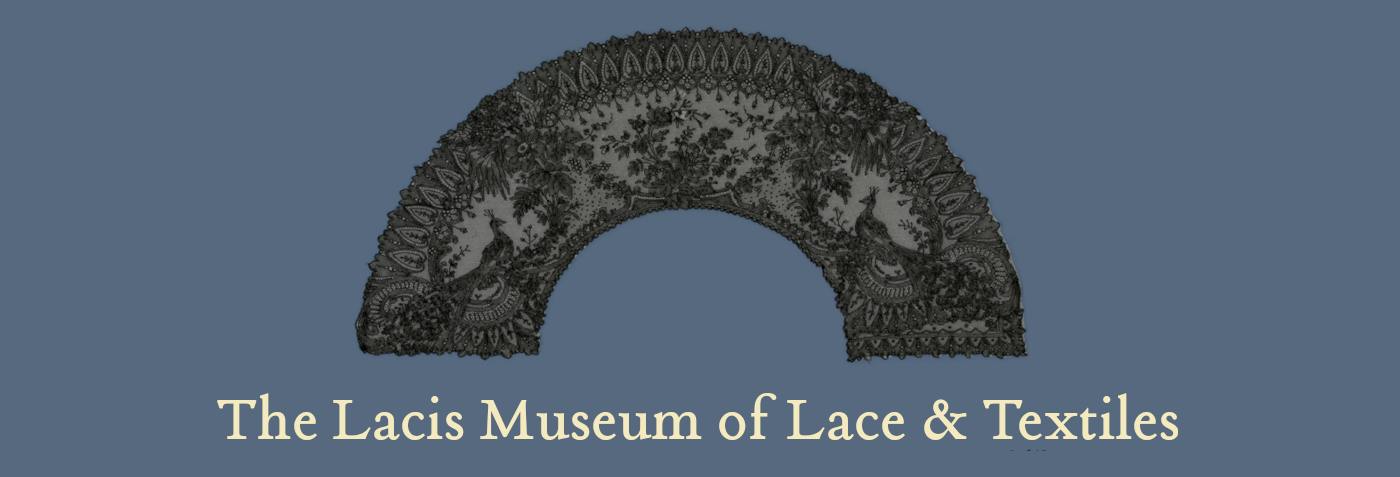

Contents in This Month's Issue
To Our Supporters
Current Exhibit: Worn to Dance—1920s Fashion & Beading
Featured Exhibits in our Museum Shop: The Crochet Art of Cathy Clark
Upcoming Exhibits: The Bird in Textiles
Treasures from Our Etsy Shop: A 1890s Bridal Gown Beauty
Textile Ephemera: A 1938 Quilting Chain Letter
New Publications: Sashiko Fundamentals, Needle Felted Friends & Whitework Wisdom
Customer of the Month: Alex Tarzynski
Join our Museum! | Subscribe to the Newsletter |
Contact Us
A Message from Our Director
In revitalizing this Newsletter link to our members and friends, we have created this new format, prepared by talented staff members. Christine and Kij with input welcomed from all associated with LMLT as well as the textile community at large. It will offer a broader range of Museum activities as well as an intimate connection with our visitors. The goal will be to publish monthly, keeping current with Museum activities and new acquisitions to the Museum and shop.
—Jules Kliot, Director
It has been some time since you last heard from us here at the museum, and we've been quite keen to resume our correspondence. We sincerely hope this letter finds you well.
You'll notice that not only have we reinstated our little news bulletin, but we've radically updated its format. This new version will be prepared by Kij and Christine of the museum staff, and fresh editions issued monthly. We'd like to share with you a broad range of our everyday museum activities, as well as giving you a more intimate behind-the-scenes perspective.
Here, we'll share everything from our latest exciting donations and acquisitions, to reviews of books and products newly arrived at the shop, to the talented work of our lovely visitors.
Our goal is to foster a stronger connection with all our Lacis friends. Therefore, we wholly welcome your input. Let us know how we're doing, how the newsletter looks on your browsers and devices, its accessibility—and definitely alert us to things you think we should mention!
Through this pandemic crisis, our lovely visitors and museum members alike have expressed great concern for our well-being. We are deeply touched that you feel so personally invested in our survival. The feeling is mutual. Without the support of the textile-loving public, we would not be here now.
The very spirit of Lacis thrives on the enthusiasm, creativity, and curiosity of our visitors—which is why we are happy to tell you that we are still open, for both curbside pick-ups, as well as in-person shopping by appointment.
Of course, the welfare of the Lacis community is ever-present on our minds. We want to assure everyone who wishes to visit us that we are diligently following all the prescribed protocols and new regulations imposed by Health Officer Orders from the City of Berkeley, and attentively minding the tier assignments for safe business practices, according to the current Alameda County risk level.
To that end, we've implemented a strict sanitation routine here at the shop. We disinfect all surfaces regularly, strictly adhere to the local face mask mandate, and limit the number of persons on the premises at any given time, so that we always have space to maneuver around each other.
We are painfully aware, of course, how arduous it has become, being confined to our homes, and how stressful and complicated the once-normal activities of life have become. At the same time, some of us have been restricted to uncomfortably close quarters with our families and roommates for far longer periods than we ever could have anticipated. And unfortunately, our normal avenues of escape are closed to us.
Lacis is uniquely positioned to offer you some creative respite. We encourage you to reach out to us if you need craft supplies, a book, material, vintage textile home goods—or even just some moral support in your artistic endeavors. Artistic people are finding new ways of channeling their creativity—and making art with renewed purpose.
Because, despite the world's present troubles, life—and art—do go on. And if the trials and tribulations of the past year have proven anything, it's that nothing can stop those unquenchable human impulses that most motivate us, who all love Lacis so dearly: those impulses of creativity and curiosity, our appetite for wonder, our capacity for imagination and dedication to our crafts.
And at Lacis, as we are weathering this pandemic, we are finding unexpected opportunities to thrive in new ways. We have taken this opportunity to clean and organize the sales floor, back stock, and classroom storage areas. We have unearthed gems that have not seen the light of day in years.
Also, we have been busily expanding our Etsy shop with a wider selection of vintage textiles and garments. (Fans of the television show The Marvelous Mrs. Maisel, keep an eye on the shoes in the upcoming Season 4—so far, we've supplied their costume department with no fewer than five pairs of gorgeous 1960s high-heeled shoes!)
We have been increasing our social media presence with regular posts on Instagram—we're @LacisMuseum. It's yet another platform (besides Facebook and this newsletter) allowing us to keep in touch with our customers, near and far, who are always engaged in exciting new projects.
And, in other digitally-related news, we've recently received the go-ahead to revamp our official Lacis Museum website, so we're eager to start giving it a much-needed update!
Again, we sincerely appreciate your continued support and engagement. Take care of yourselves, and keep creating—and until next time,
Kind regards, and many thanks—
Your friends at Lacis
NOTE: Temporarily shut due to local COVID-19
Due to the extenuating circumstances of the past pandemic year, the timeline for this exhibition will be expanded so that all those who missed the opportunity to enjoy it may have a chance to do so in the future.
Almost 100 years ago, with the dawn of the Jazz Age, life changed dramatically for women in America. Suddenly the 1920s woman could vote, drive, spend her own money, smoke and drink in public, cut off her long hair, expose her calves, forgo her corset and—perhaps most iconic of all—she could dance.
The most iconic pastime of the 1920s was dancing in nightclubs and speakeasies. Here women and men could freely socialize to the rhythm of Hot Jazz.
That rhythm is most clearly made visual in the image of the flapper, with her (relatively) short dress, which sparkled in the dim lights, given heft, form and movement by the innumerable beads sewed to its simple shift-shaped form.
These dresses, like the Jazz Age itself, were never destined to last. With the weight of the beads continually testing their union with the fragile silk, their eventual collapse was inevitable, as evidenced by the beads abandoned on the dance floor when the party was over.
This is why, though the dresses remained the quintessential symbol of the times, so few of them remain today. By attentive restoration, we have been able to present examples of these dresses as they appeared when they first shone, as well as fascinating examples of dresses in different stages of construction process.
From the collection of LMLT; conceived of and curated by the LMLT staff
Running from November 16, 2019—Extended end date TBD

Shetland Lace Sampler
This generous donation of decorative textile artworks from Cathy Clark is a tour de force of talent and devotion to the world of needlework, specifically her world of knitting and Shetland yarns. "I fell in love with Shetland sheep and their fleeces," she confesses, "and that has ruled my life since 2007."
The magnificent sampler she constructed in 2012 is 8 feet by 6½ feet, comprising 67 different fleeces of yarn, all hand-spun by Cathy herself. We also have her personally compiled tome of sketches available for your perusal, with each motif and its pattern, along with sources and progress reports, all passionately and fastidiously documented.
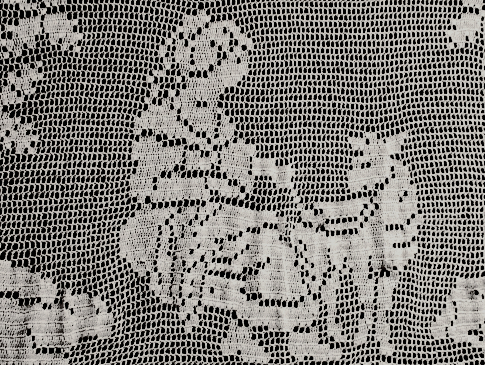
Filet Crochet Panels
These monumental window coverings that hung in the remote log house of Cathy Clark's childhood depict a fabulous range of animals, as well as a fascinating pastoral series, concentrating on a theme dear to Cathy's heart—sheep!
On your next visit to Lacis, don't miss Cathy's butterflies and birds, the colossal imposing owl, a lively provincial scene featuring rooster and hens, and the peacock posed in all his glory! In the wool industry-related sequence, we see a dog diligently guarding its flock, a shepherdess in the process of shearing, and presumably the same maiden seated, spinning wool. These lively, cheerful representations must have made their rustic abode truly cozy and homey.
We can't wait to share this gorgeous exhibit with you all soon!
For the time being, please enjoy this extract from the exhibit commentary.

6 Fighting Birds on a Buddhist Shawl [12441]
The ravages of time have left only fragments of this piece behind. Due to its disintegrated nature, the action takes place seemingly in a void. The heavily embroidered portions, having their own integral strength, are mounted onto a newer backing. (In antique textiles, we often see that black background silks, which were dyed using iron mordant, irrevocably breaking down over time.)
Yet what we can still observe clearly is the compositional opposition of black and white, accented by the red of the maple leaves. As the chaotic violence of the birds in furious motion sends a flurry of these leaves scattering into the air, the significance of their blood-red color could not be more emphatically clear.
The melee involves four black birds attacking a pair of white herons. Japanese Buddhism has long associated shorebirds like herons and cranes with the practice of meditation, renowned as they are for their habit of enduring interminable periods of perfect serenity in the water, often while impossibly balanced on a single leg. Meanwhile, in the west, the heron is a frequent symbol of solitude and independence—as in, for example, the eponymous would-be trophy bird in Sarah Orne Jewett's 1886 story, A White Heron.
No creature, then, more aptly represents the Buddhist monk or nun who shuns the material world. Are these territorial crows an allegory for the distractions of the superficial world, which persistent in disturbing the spiritual seeker on their quest for inner peace?
White egrets standing in opposition to black corvids is a decorative motif found on several celebrated Japanese screens (like Shibata Zeshin's, from the 19th century, and Hasegawa Tohaku's, from the 16th). It makes sense that such a polarized design—wherein the black flock attempts to intimidate, or mob outright, the aloof white birds—would proliferate in a culture that so highly elevates contemplation and esteems self-control.
NOTE: To keep abreast of all new developments with regard to local museums, please refer to Alameda County's COVID-19 Arts and Culture Resources.

Handmade in New York by A. F. Jammes of Hautes Nouveautés.
This absolute stunner of an antique garment features classically Victorian long sleeves and a high-throated neck, followed by a dramatic, sweeping train. Miss Jennings (for whom the dress was made, and whose name appears in exquisite script on a discreet inner label) must have felt like a true queen on her wedding day.
A museum deaccession, this item is in remarkably good shape. The fine couture detailing speaks to the highest level of craftsmanship—not to mention expense. The front is lavishly trimmed with a gathering of exquisite handmade Point de Gauze. And notice the small, tender rosebuds circle the neck in a ruffle of soft tulle? They cascade down the center of the lace, and peek out again at the hems of the wrists.
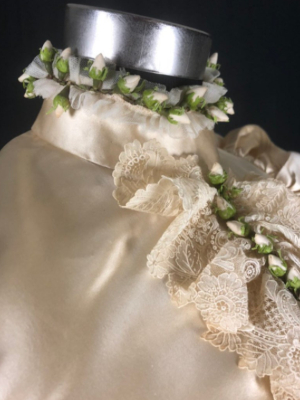
Tiny rosebuds and delicate Point de Gauze lace.
In true late-19th century style, the sleeves stand tall, highly gathered at the shoulder line and taper down the arms into a curved hem at the wrist, while the "Watteau" style drape falls elegantly down the back, and a deep box pleated ruffle of satin ribbon decorates the inner hem. A silk bengaline lining covers no fewer than eleven stays and fasteners, and the bodice closes in the front with several layers of hook fastenings and a row of snaps at the high collar.
This historied wedding dress is priced at $5,000, shipping included. Intrigued? You can read further about this rare beauty on our Etsy page, where you'll find more photographs, as well as a comprehensive description of its condition.

This month, take a look at an incredible piece of handwritten correspondence—complete with envelope, letter, and two pattern pieces cut from tissue paper. In pencilled longhand on faintly blue-lined writing paper, this is a quilting chain letter from Nebraska, 1938.
It contains directions sent from a PO Box in Nebraska to Mrs. Anna McCullough of Brady, Nebraska,
in July of 1938. The other recipients included Mrs. A. C. Williamson of Alhambra, California;
Mrs. J. D. Ogden; and Mrs Jerry Snyder, both of Maxwell, Nebraska (about ten miles
from Brady, Nebraska).
Find yourself transported back in time and read the letter's ingenious instructions:
"Please piece one of the blocks from enclosed pattern and send to lady whose name appears at top of list. Make 3 copies of this letter and send to friends whom you know will not break the chain. When sending, leave off name at top of list and add yours at the bottom of list. When your name appears at the top of list you will receive enough blocks for a quilt. Send within 3 days and be sure to send pattern with each letter."
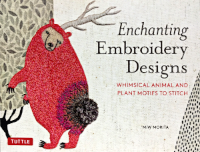
Tuttle Publishing, $15.00 FX51
Ceramicist and painter Morita MiW embroiders with such beguiling charm and character. (Definitely check out her extensive art portfolio—it's gorgeous!) Her subjects range from woodland creatures to moss and microbes, all stylized with simplicity and sweet naiveté of folk art. Ideal for precocious kids who need an inviting introduction to embroidery, but perfectly approachable for adults, too.
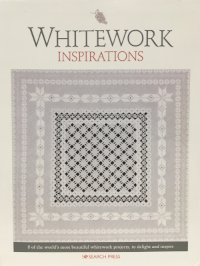
Search Press, $26.00 PQ93
This lovely large-format paperback you step-by-step through 8 varied whitework projects, with detailed graphics and excellently done close-up pictures. More than a simple how-to, it also contains illuminating insights about the history of whitework embellishment—but the real pièce de résistance of this book is its supremely handy stitch guide, which takes you step-by-step through about 60 of the most commonly-employed embroidery stitches, replete with helpful photographs.
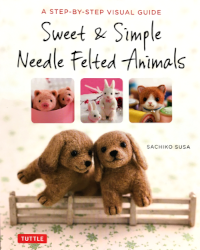
Tuttle Publishing, $15.00 FX54
This book shows you how to make very appealing, super-cute and tiny wool friends. Most helpfully, it shows them in photographs to scale, including views from every angle, and is sprinkled with expert tidbits of advice (such as weighing your wool and the dynamics of realistic animal anatomy, as they apply to the super-cute chubby style).
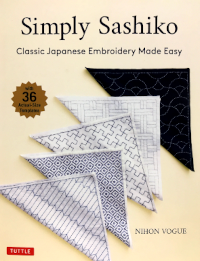
Tuttle Publishing, $17 FX50
This book is seriously exciting. It's hands-down the single most useful and approachable introduction to Sashiko we've ever seen! The organization, visuals, and highly practical demonstration of methods makes it the sashiko book we've been waiting for. And we just can't seem to keep it on the shelves—Japanese mending and quilting techniques are taking the world by storm, and every stitching enthusiast we've shown this book too immediately wanted their own copy!
One of our favorite things to see is when our young Lacis friends teach themselves lacemaking. Alexander is one of those admirable people! He's only been practicing for a couple of months now, and check out his incredible progress!
Due to the pandemic, our own bobbin lace workshops are sadly on hiatus, so all that you see here is entirely a credit to Alexander's own steam, motivation, and dedication—yet still, we are absurdly proud. Lacemaking is being kept very much alive into this next generation, and we at Lacis feel honored to be supplying new artisans and craftspeople with the essentials they need to do just that. Watching their growth and the fruits of their drive and creativity is its own reward!
The Lacis Museum of Lace and Textiles is a 501(c)(3) non-profit corporation. We are a unique legacy museum located in Berkeley, California. We host a wide range of hands-on workshops, several galleries of rotating exhibits, and our museum shop carries an extensive supply of vintage goods, craft- and costume-related books, and needlework supplies.
Our purpose is to:
• Preserve lace and textiles of all cultures from all periods
• Provide a resource center for research and documentation of these objects
• Educate and disseminate knowledge of lace and textiles
For an annual fee of $25.00, you can become an official, card-carrying Lacis Museum Member and enjoy exclusive benefits! You can get your membership via our Etsy shop, or alternatively, contact us in a number of other ways to join this vitally important circle of Lacis friends. We thank you for your support!
• 20% off books purchased at the Lacis Museum shop
• Free museum admission for you and up to (4) guests
• Special invitation to show openings
• Class discounts
Closing Thoughts from Our Director
This past year has challenged the existence of our Museum, kept alive only by the sales room where visitors are welcomed by appointment. The Exhibits and classes are what made LMLT a special place. Classes were all cancelled and no new ones yet scheduled. Exhibits exist and ready to welcome visitors as soon as groups are allowed to form. Plans are being prepared for creating elevator service to the upper floor classrooms and Gallery, anticipating a soon revitalization of activities. Most of all, we look forward to seeing again the special friends we have made from our 1964 pre-museum origins where Kaethe reigned, through the creation of the Museum in 2004 as a living memorial to Kaethe; and till this present moment in time.
—Jules Kliot, Director
